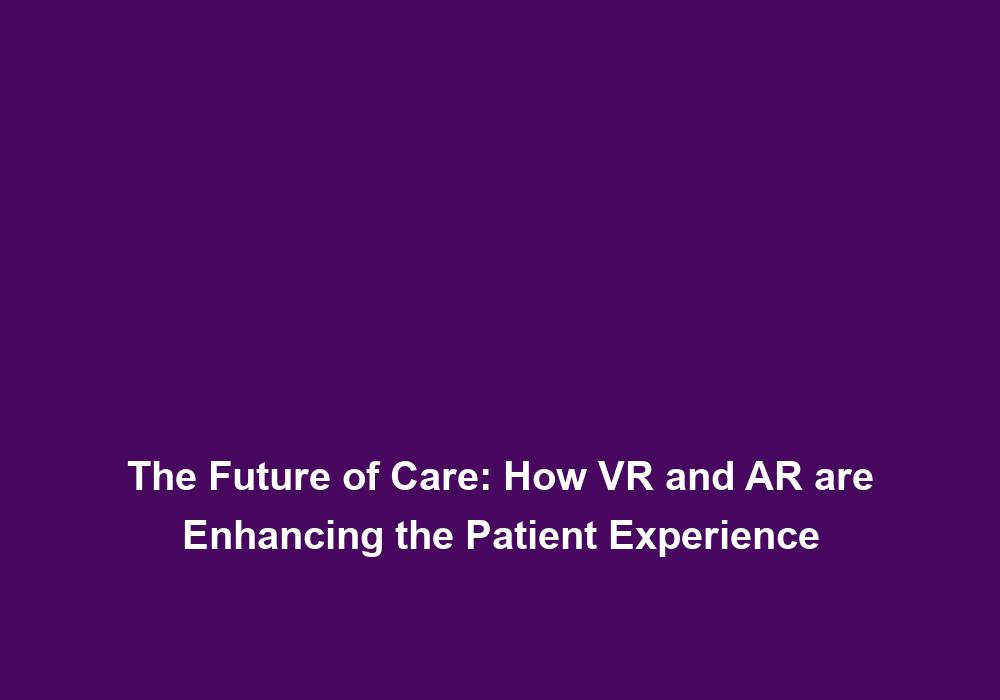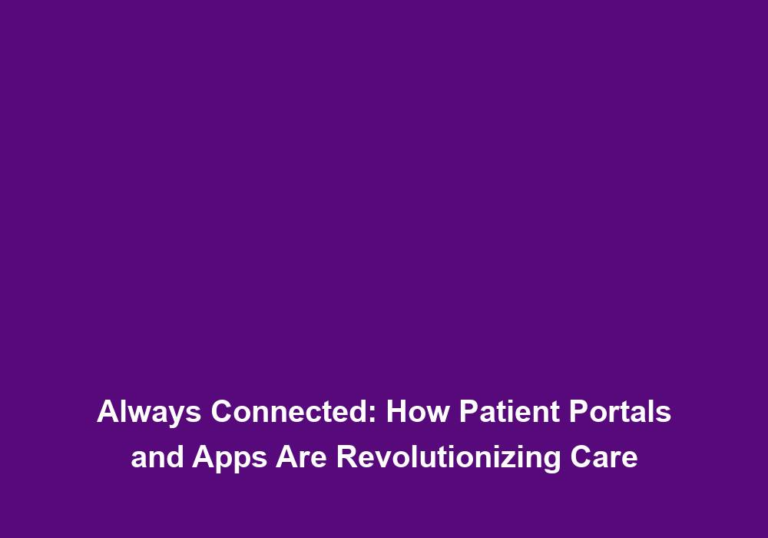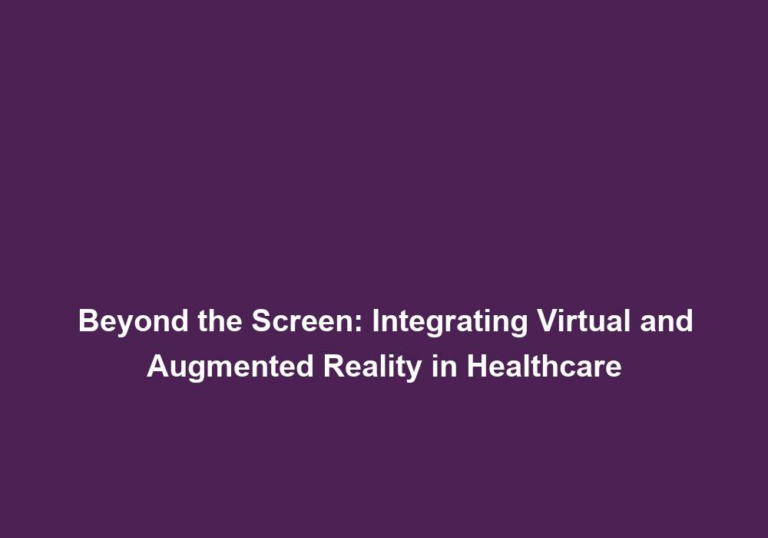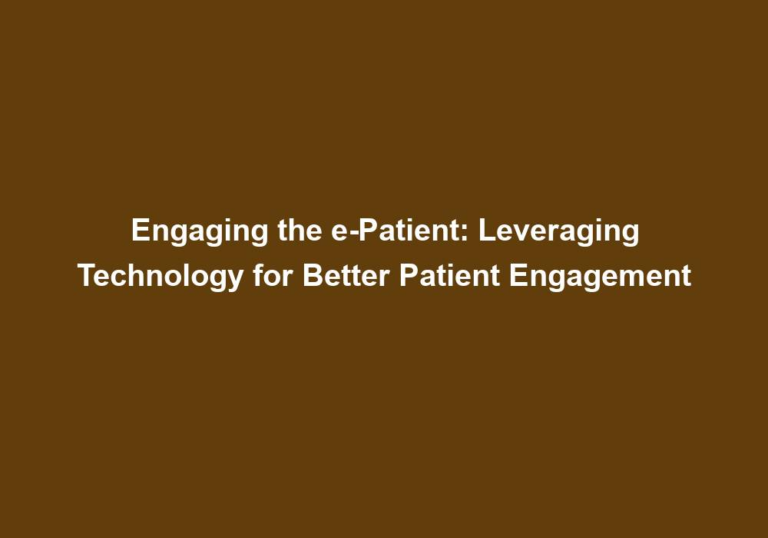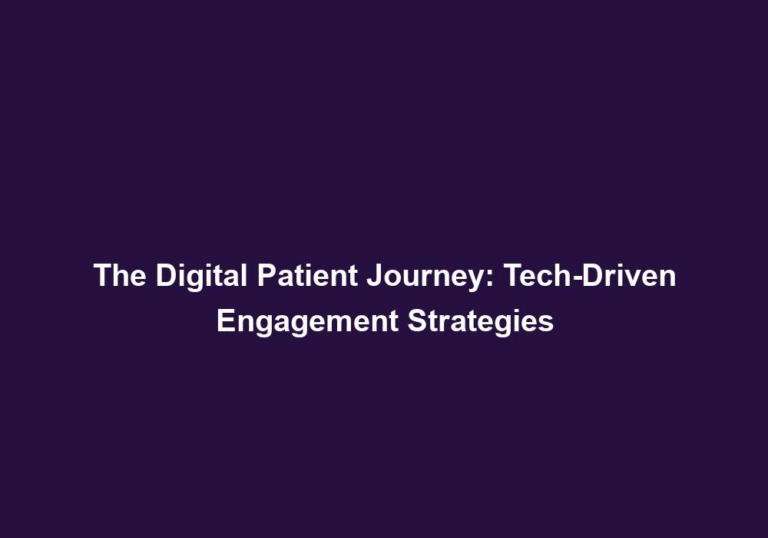The Future of Care: How VR and AR are Enhancing the Patient Experience
The healthcare industry has undergone significant advancements in recent years, with technology playing a crucial role in revolutionizing patient care. Among these technological innovations, Virtual Reality (VR) and Augmented Reality (AR) have emerged as powerful tools in enhancing the patient experience. By providing immersive and interactive experiences, VR and AR have the potential to transform various aspects of healthcare, from diagnosis and treatment to rehabilitation and mental health support.
The Power of Virtual Reality in Healthcare
Virtual Reality, often referred to as VR, is a computer-generated simulation that immerses users in a three-dimensional environment, replicating real or imagined worlds. In the context of healthcare, VR offers a range of applications that can positively impact the patient experience.
1. Pain Management and Distraction Techniques
VR has shown promising results in reducing pain and anxiety during medical procedures or chronic conditions. By immersing patients in a virtual environment, healthcare providers can divert their attention away from the pain or discomfort they may be experiencing. Studies have demonstrated that VR distraction techniques can significantly decrease pain perception, making procedures more tolerable for patients.
Furthermore, VR can provide a range of distraction techniques to manage pain. These techniques can include immersive experiences such as virtual tours, games, or storytelling. By engaging patients in these interactive activities, VR helps to shift their focus away from the medical procedure, reducing the perception of pain and promoting relaxation.
In addition to managing physical pain, VR can also be used to alleviate anxiety and stress. By creating calming virtual environments, such as serene landscapes or peaceful beaches, VR can help patients relax and reduce their anxiety levels. This has the potential to improve the overall patient experience and increase their satisfaction with the healthcare encounter.
2. Rehabilitation and Physical Therapy
VR can also be utilized to enhance rehabilitation and physical therapy programs. By incorporating interactive games and simulations, patients can engage in enjoyable activities that promote movement and exercise. This not only increases motivation but also helps in measuring progress and tracking performance. VR-based rehabilitation programs have shown improved outcomes in stroke recovery, balance training, and motor skill development.
In addition to traditional physical therapy exercises, VR can provide a more engaging and immersive experience for patients. For example, instead of performing repetitive exercises, patients can use VR to participate in virtual sports or games that require specific movements and coordination. This gamification of rehabilitation can increase patient motivation and adherence to therapy programs.
Furthermore, VR can also offer real-time feedback and data collection during rehabilitation sessions. By tracking patient movements and performance metrics, healthcare providers can monitor progress and make necessary adjustments to optimize outcomes. This objective measurement of progress can provide patients with a sense of achievement and encourage them to continue their rehabilitation journey.
3. Medical Training and Education
VR has the potential to revolutionize medical training and education by providing immersive learning experiences. Medical students can practice complex procedures and surgeries in a controlled virtual environment, reducing the risk associated with real-life training scenarios. VR simulations can also be used to enhance the understanding of anatomical structures and facilitate collaborative learning among healthcare professionals.
In the field of medical training, VR offers a safe and realistic environment for students to hone their skills. They can practice intricate surgical techniques without endangering patients’ lives, allowing them to gain confidence and proficiency before performing procedures in real-world settings. VR simulations can also simulate rare or challenging cases that students may not encounter frequently, providing them with exposure to a diverse range of scenarios.
Moreover, VR can enhance the understanding of complex anatomical structures. By immersing users in virtual environments, medical students can explore the human body in a three-dimensional space, gaining a deeper understanding of anatomical relationships and structures. This immersive learning experience can improve knowledge retention and enhance the ability to apply theoretical concepts to practical situations.
Additionally, VR can facilitate collaborative learning among healthcare professionals. By connecting multiple users in a shared virtual environment, healthcare providers can engage in team-based training and decision-making exercises. This fosters effective communication and coordination, vital skills in delivering quality patient care.
4. Mental Health Treatment
VR technology can play a vital role in the treatment of mental health conditions such as post-traumatic stress disorder (PTSD), phobias, and anxiety disorders. Virtual environments allow therapists to create controlled scenarios that expose patients to their fears or triggers in a safe and controlled manner. This exposure therapy, combined with cognitive and behavioral interventions, can help individuals overcome their anxieties and traumas.
One of the key advantages of VR in mental health treatment is its ability to recreate real-life situations in a controlled and customizable manner. For individuals with phobias or anxiety disorders, VR can simulate scenarios that trigger their fears, allowing them to gradually confront and overcome them. This gradual exposure, accompanied by therapeutic interventions, helps desensitize patients to their triggers and reduces the severity of their symptoms.
Furthermore, VR can provide a safe space for individuals with PTSD to process and confront traumatic memories. By recreating specific environments or situations associated with their trauma, therapists can guide patients through the healing process in a controlled and supportive environment. This immersive therapy can lead to significant improvements in symptoms and overall well-being.
Moreover, VR can offer interactive tools and coping mechanisms to manage stress and anxiety. For example, mindfulness exercises and relaxation techniques can be integrated into virtual experiences, allowing individuals to practice self-soothing strategies in a virtual setting. This empowers patients with tools they can utilize in their daily lives to alleviate distress and maintain their mental health.
Augmented Reality: Enhancing Real-World Experiences
While virtual reality immerses users in a completely digital environment, augmented reality (AR) overlays digital information onto the real world. AR enhances the patient experience by providing valuable real-time information, improving accuracy, and streamlining various healthcare processes.
1. Accurate Medical Visualization
AR technology enables healthcare professionals to visualize medical scans, such as CT or MRI images, in the real world. By overlaying digital images onto the patient’s body, physicians can gain a better understanding of complex anatomical structures during surgical planning or interventions. This enhances precision, reduces risks, and improves patient outcomes.
With AR, healthcare providers can have a comprehensive view of the patient’s anatomy during surgical procedures. By wearing AR-enabled glasses or using handheld devices, surgeons can see the patient’s internal structures overlaid onto their physical body, facilitating accurate spatial awareness and precise surgical navigation. This technology can help identify critical structures, such as blood vessels or nerves, and reduce the risk of inadvertent damage during surgeries.
In addition, AR can assist in the placement of medical devices or implants. By overlaying digital guides onto the patient’s body, healthcare professionals can ensure accurate positioning and alignment, minimizing complications and improving the success rate of procedures. This real-time visualization enhances the efficiency and effectiveness of interventions, resulting in better patient outcomes.
2. Enhanced Surgical Navigation
AR offers surgeons real-time guidance during complex procedures. By projecting critical information onto a surgeon’s field of view, AR enables them to accurately locate structures, assess depths, and identify vital anatomical landmarks. This augmented information improves surgical precision and reduces the risk of complications.
During surgical procedures, AR can provide surgeons with essential information, such as real-time imaging, patient data, or instrument tracking. By overlaying this information onto their visual field, surgeons can maintain focus on the patient while simultaneously accessing critical data. This augmented guidance allows for more precise incisions, optimal placement of implants, and improved overall surgical outcomes.
Moreover, AR can facilitate the sharing of knowledge and expertise among surgical teams. By projecting the surgeon’s view onto a remote location, AR enables real-time collaboration and consultation with other healthcare professionals. This virtual presence can enhance communication, enable mentorship opportunities, and ensure the delivery of high-quality surgical care across different geographical locations.
3. Remote Consultations and Telemedicine
AR can facilitate remote consultations and telemedicine by allowing healthcare professionals to virtually assess patients’ conditions. By wearing AR-enabled glasses, physicians can see and interact with patients in real-time, even when physically distant. This technology can bridge the gap between patients and specialists, especially in rural or underserved areas, ensuring timely access to healthcare services.
In telemedicine, AR can provide a more immersive and interactive experience for both patients and healthcare professionals. By overlaying digital information onto the patient’s live video feed, physicians can perform remote examinations, provide real-time guidance, and make accurate assessments. This can be particularly useful in situations where physical access to healthcare facilities is limited or when immediate medical attention is required.
Furthermore, AR can enhance the capabilities of remote healthcare teams during emergencies or disaster situations. By sharing live video feeds with remote specialists, healthcare providers on-site can receive real-time guidance and expertise, improving decision-making and patient outcomes. This technology enables effective collaboration and coordination, even in high-pressure and time-sensitive scenarios.
4. Personalized Patient Education
AR can enhance patient education by providing interactive and personalized experiences. By overlaying information onto real-world objects, patients can visualize their own conditions, treatment plans, and medication instructions. This improves patient comprehension, adherence to treatment regimens, and overall engagement in their healthcare journey.
With AR, patients can have a more comprehensive understanding of their medical conditions and treatment options. By overlaying digital models onto their own bodies or physical objects, such as medical devices or medication packaging, patients can visualize how these elements interact and affect their health. This visual representation enhances patient comprehension and empowers them to actively participate in their treatment decisions.
Moreover, AR can provide interactive educational materials tailored to each patient’s specific needs. By presenting information in a visually engaging and interactive manner, patients are more likely to retain knowledge and follow treatment instructions. For example, AR can guide patients through medication administration techniques or demonstrate proper use of medical devices, promoting safe and effective self-care practices.
Overcoming Challenges and Embracing the Future
While VR and AR present numerous opportunities to enhance the patient experience, there are challenges that need to be addressed for widespread adoption and integration into healthcare settings. Some of these challenges include cost, accessibility, data privacy, and technological limitations. However, with continued research, development, and collaboration between technology and healthcare experts, these challenges can be overcome, paving the way for a future where VR and AR play a prominent role in patient care.
In conclusion, Virtual Reality (VR) and Augmented Reality (AR) have the potential to transform the future of healthcare by enhancing the patient experience. From pain management and rehabilitation to medical training and mental health treatment, VR and AR offer innovative solutions that improve outcomes, increase engagement, and revolutionize traditional healthcare practices. As we embrace these technologies, the healthcare industry moves closer toward a future where personalized, immersive, and patient-centric care becomes the norm.
Note: This article has been generated by OpenAI’s GPT-3 and may contain some errors or inaccuracies. Please verify any information presented with additional sources before using it as a reliable reference.

